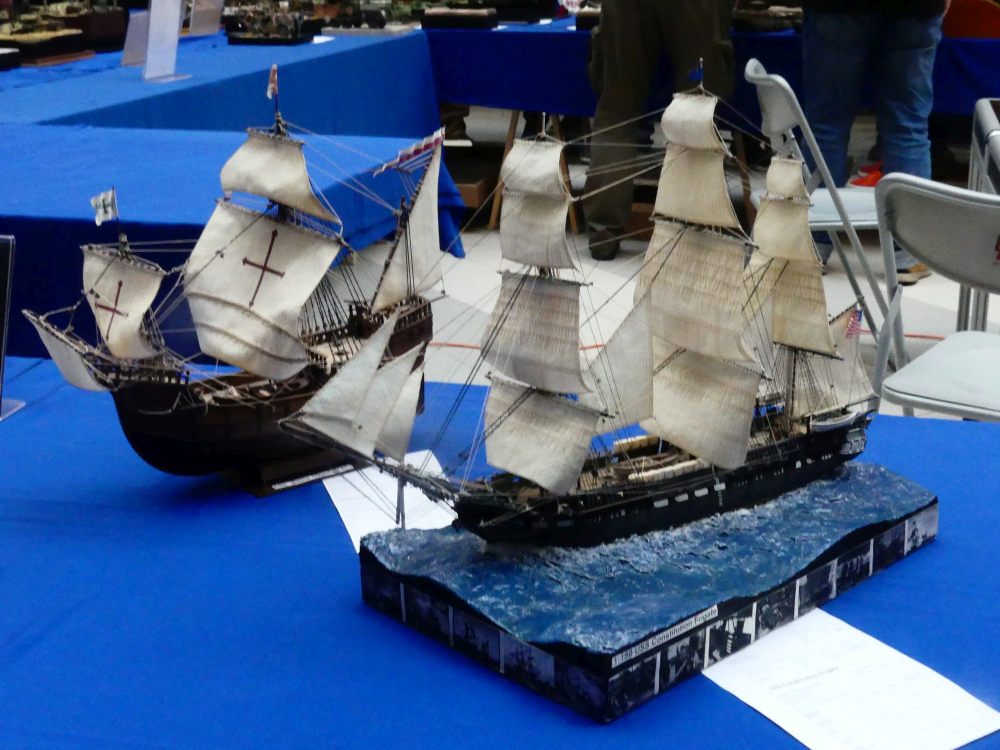Contents tagged with tit_hajózástörténeti_modellező_és_hagyományőrző_egyesület
-
A XVIII. Bolyai Makettépítő Kupán jártunk
2022. október 08-09-én került megrendezésre a budapesti China Martban a XVIII. Bolyai Makettépítő Kupa, amelyen a szervezők felkérésére egyesületünk tagjai – Dr. Ákos György, a Hajózástörténeti Tagozat vezetője és Hocza István titkár – a zsűri soraiban képviselték szervezetünket. A hagyományosan az alkotások zömét képező szárazföldi harcjárművek és figurák mezőnyében idén is akadtak egyedi, szép kivitelű hajók. Ezeket és a mezőny néhány igazán különleges alkotását mutatja be albumunk (fotó: Ákos György).
Az egyesületünk részvételével zajlott korábbi versenyek: 2021-ben és 2015-ben.
-
A NAVIGA C kategória nemzetközi versenye Budapesten
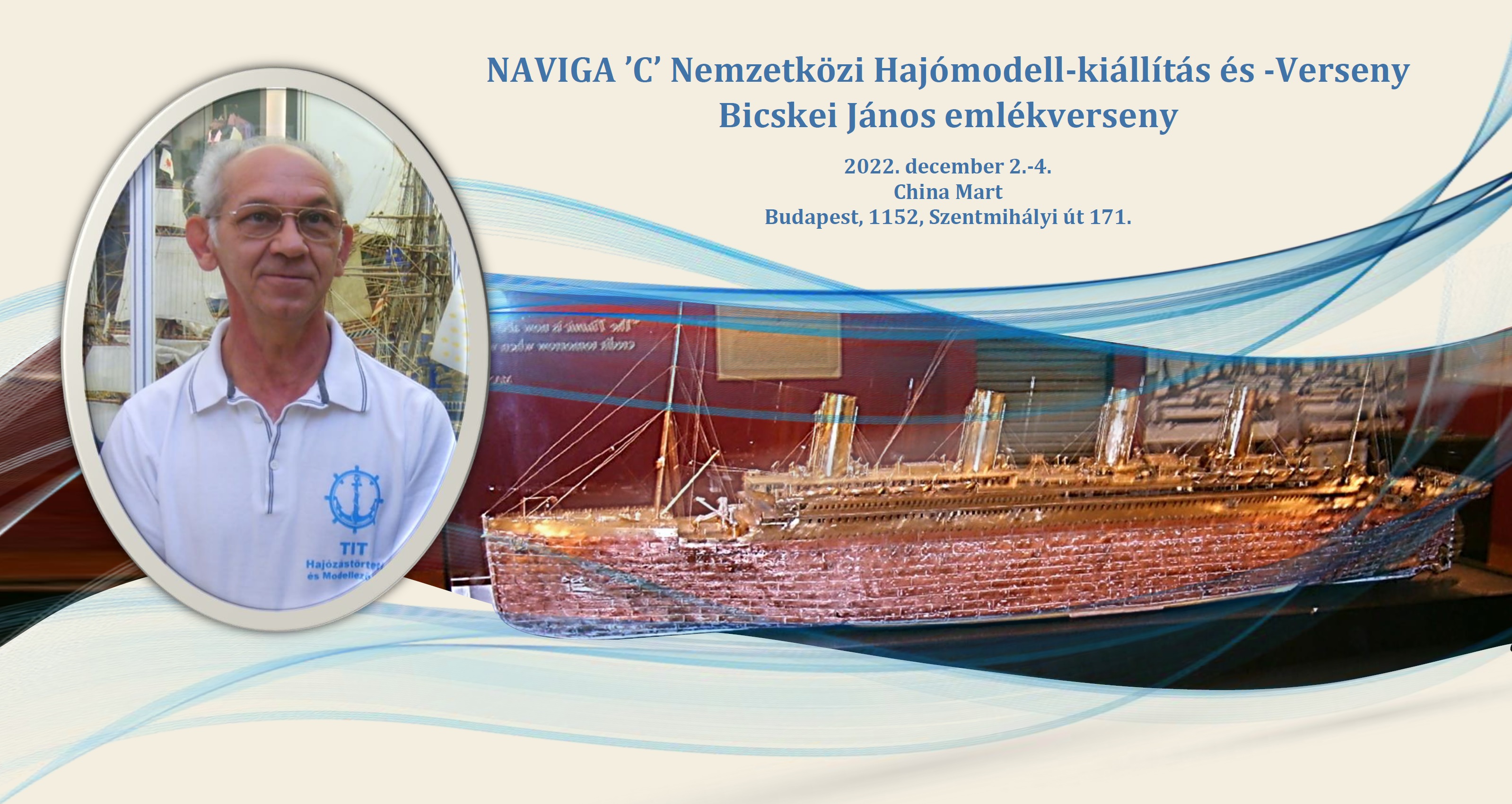
A közép-európai országok hajómakett- és -modellépítői rendszeresen összegyűltek minden év kora-tavaszán Bécsben, ahol a Go Modelling rendezvénysorozat keretében adtak rangadót egymásnak. A térség alkotóinak és alkotásainak seregszemléje lehetőséget adott az évről-évre újonnan elkészült alkotások bemutatására és versenyére, valamint szakmai programok (előadások és vásárok) lebonyolítására. A COVID-19 világjárvánnyal azonban ez a lehetőség megszűnt. Bécs nem fogad többé modellezőket ezzel a céllal.
Erre tekintettel, s annak érdekében, hogy a hajómodellek tekintetében az éves megmérettetés és szemle lehetőségét az érdeklődők számára megteremtsék, Kornis János, a NAVIGA NS szekcióvezetője javaslatára, összefogtak a hajómodellezésben érintett civil szervezetek – Egyesületünk, s a csepeli Weiss Manfréd Technikum, Szakképző Iskola és Kollégium Középiskolai Modellező Szakosztálya – hogy a NAVIGA C szekció szabályai szerinti 8 kategóriában nemzetközi makett- és modellversenyt rendezzenek.
A versenykiírás: itt.
A versenyhelyszín: itt.
A rendezvény FB-eseménye: itt.A versenybe nevezett alkotásokat neves nemzetközi bírói testület értékeli, Dieter Matysik (Németország) vezetésével és Giuseppe Giraldi (Olaszország), valamint Alberto Maretti (Olaszország) közreműködésével. A szervezők kifejezett célja annak biztosítása, hogy – amennyiben sikerül kedvező tapasztalatokat szerezni a lebonyolítással összefüggésben – a következő évtől rendszeresen Európa-bajnokságon lássák vendégül Magyarországon a kategória hazai és külföldi alkotóit. Ebben kellő támogatást jelentenek számukra a NAVIGA világversenyeken való részvétel során, illetve az ilyen versenyek megszervezésében és lebonyolításában a korábbi években szerzett gyakorlati tapasztalataik (bővebben itt, itt és itt).
Kornis János kezdeményezésére, s a szervezők egyetértésével a verseny az öt évvel ezelőtt elhunyt Bicskei János – egyesületünk 2007-2016 közötti titkára – nevét viseli, az általa a hazai hajómodellezés érdekében kifejtett tevékenysége eredményeire, elévülhetetlen érdemeire és lelkesítő személyiségére emlékezve.
Bicskei Jánosról, karakteréről és teljesítményéről az alábbiakban azok is képet kaphatnak, akik nem ismerhették őt személyesen a temetésén elhangzott búcsúbeszédek (itt és itt), valamint János fontosabb alkotásai - az RMS TITANIC M=1:100 méretarányú modellje, az FN 122 M=1:1 méretarányú rekonstrukciója, a LEITHA/LAJTA Monitor Múzeumhajó Nordenfelt szórólövegeinek M=1:1 méreatrányú rekonstrukciója - és János eredményeinek állami elismerése alapján.
-
Beszámoló a történelmi vitorláshajó makettezők XIV. országos találkozójáról
Egyesületünk szervezésében 2022. szeptember 17-18-án került sor a Történelmi Vitorláshajó Makettezők XIV. Országos Találkozójára, amikor Pálvölgyi József tagtársunk birtokán újra összegyűlt a hajósnép.
Az utóbbi évek találkozóiról készült képek és beszámolók elérhetők a következő linkeken
(2017-ből itt; 2018-ból itt és itt; 2019-ből itt, 2020-ból pedig itt).
Az idei seregszemlén 23 befejezett, vagy építés alatt álló történelmi vitorlás- és egyéb hajó makettjét mutatták be építőik az ország minden részéből, az M=1:50 méretarányú hatalmas múzeumi modellektől az M=1:700 méretarányú mikromodellekig, mint például Horváth Zoltán HMS VICTORY-ja, vagy Pék György HMS QUEEN ELIZABETH csatahajója (lent).
A bemutatott munkák között olyan egyedi alkotásokat is megtekinthettek az érdeklődők, mint például a ZSÓFIA FŐHERCZEGNŐ nevű dunai lapátkerekes személyhajó gőzüzemű, működőképes gépházi metszetmodelljét (Valentinyi Gyula alkotása).
Az alkotások közül 12 makett az építés különböző fázisaiban van, így a következő esztendőkben ezek építésének előrehaladását is figyelemmel kísérhetjük.

A bemutatót vetített képes előadások kísérték a házigazda Pálvölgyi József részéről a délangliai Portsmouth haditengerészeti bázisán a történelmi dokkoknál tett nyári utazás élményeiről, Dr. Ákos György részéről a jelenleg felújítás alatt álló HMS VICTORY sorhajónak a restauráció miatt éppen nem látogatható részeiről, Gigler László részéről a SZENT ISTVÁN csatahajó M=1:100 méretarányú makettjéről, végül Dr. Balogh Tamás részéről a 2022. évi LUSITANIA-expedíció eredményeiről.
Külön öröm volt látni, hogy a hajómodell-építő szakma veteránjai is rendszeres résztvevői a rendezvénynek, amelyet évről évre maguk is új alkotásokkal gazdagítanak.
A szervezésben és lebonyolításban közreműködő minden kedves tagtársunknak, a megjelent érdeklődőknek és kiállítóknak, s a házigazdának, Pálvölgyi Józsefnek ezúton is köszönjük a nagyszerű munkát és a jó hangulatot, amelyben idén is találkozhattak egymással a hajózás és a hajómakett-építés szerelmesei!
A találkozón készült további képek egyesületünk Facebook-oldalán elérhetők. -
Elveszett óceánjárók titkai VI. - AMERICA
Az "Elveszett óceánjárók titkai" című vadonatúj hatrészes dokumentum-film sorozat első epizódját 2022. július 27-én, szerdán 21:00 órakor kezdték el vetíteni a Sky/History televíziós csatornán az Egyesült Királyságban. A hat epizód vetítésére az alábbiak szerint kerül sor: NORMANDIE (2022.07.27.), QUEEN ELIZBETH (2022.08.04.), ANDREA DORIA (2022.08.11.), REX (2022.08.18.), CAP ARCONA (2022.08.25.), AMERICA (2022.09.01.). A nemzetközi adások valószínűleg később, 2022-2023 folyamán következnek.
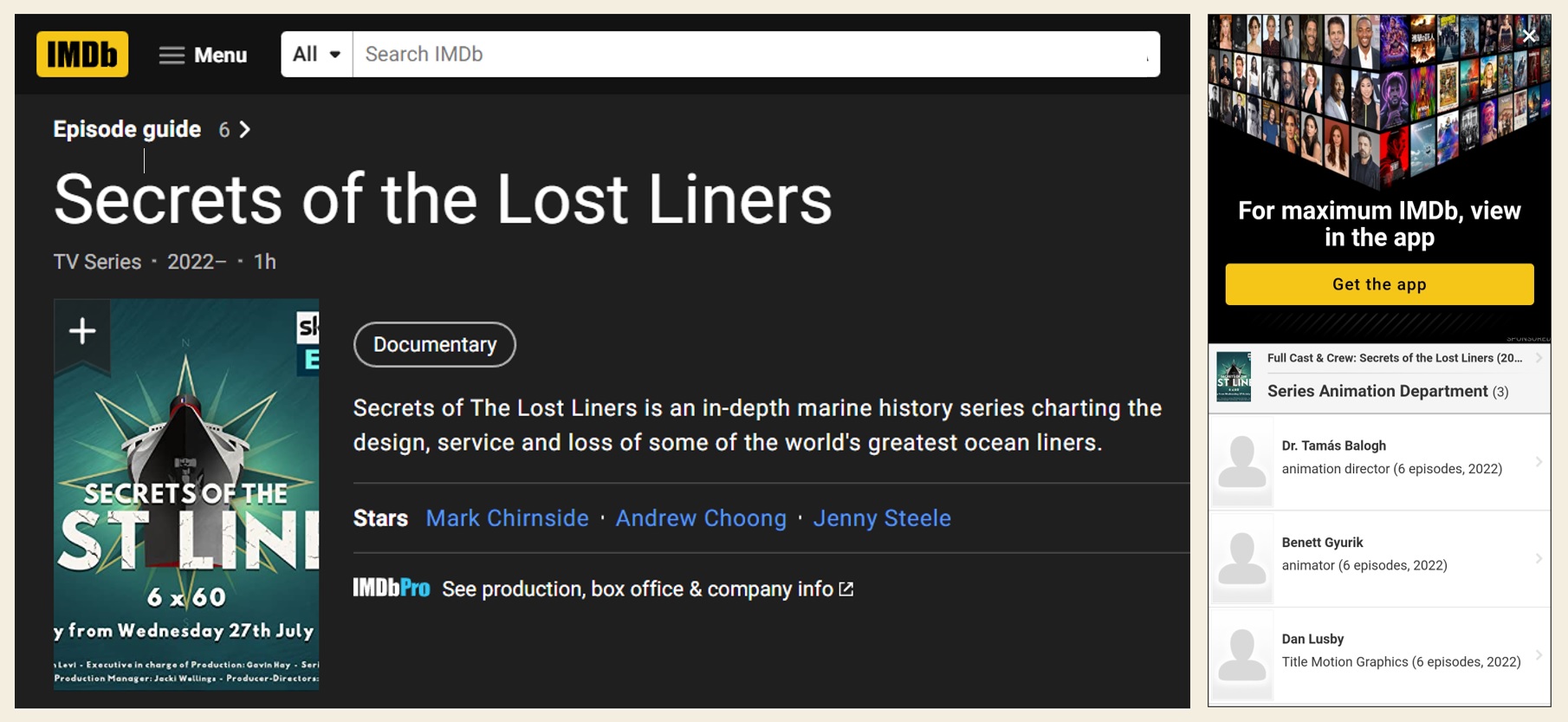
Ez a legkiterjedtebb és legrészletesebb 6 x 1 óra a témában. Az óceánjárók egy évszázadnyi történetét feltérképezve a legtájékozottabb szakértők és szerzők mesélnek arról, hogyan tervezték, építették ezeket a hajókat és hogyan szolgáltak az óceánon, s végül hogyan váltak a háború, balesetek, vagy emberi mulasztások áldozatává.
A sorozat bemutatásának megkezdése alkalmából az egyes epizódok vetítésének napján közreadjuk az adott epizódban szereplő óceánjárók történetéhez kapcsolódó kutatásokat összefoglaló háttéranyagokat és a sorozatban megjelenítendő animációkhoz készített előzetes terveket, amelyeket egyesületünk elnöke, Dr. Balogh Tamás készített, aki a sorozatban bemutatott műszaki animációk elkészítéséért felelős rendezőként dolgozott.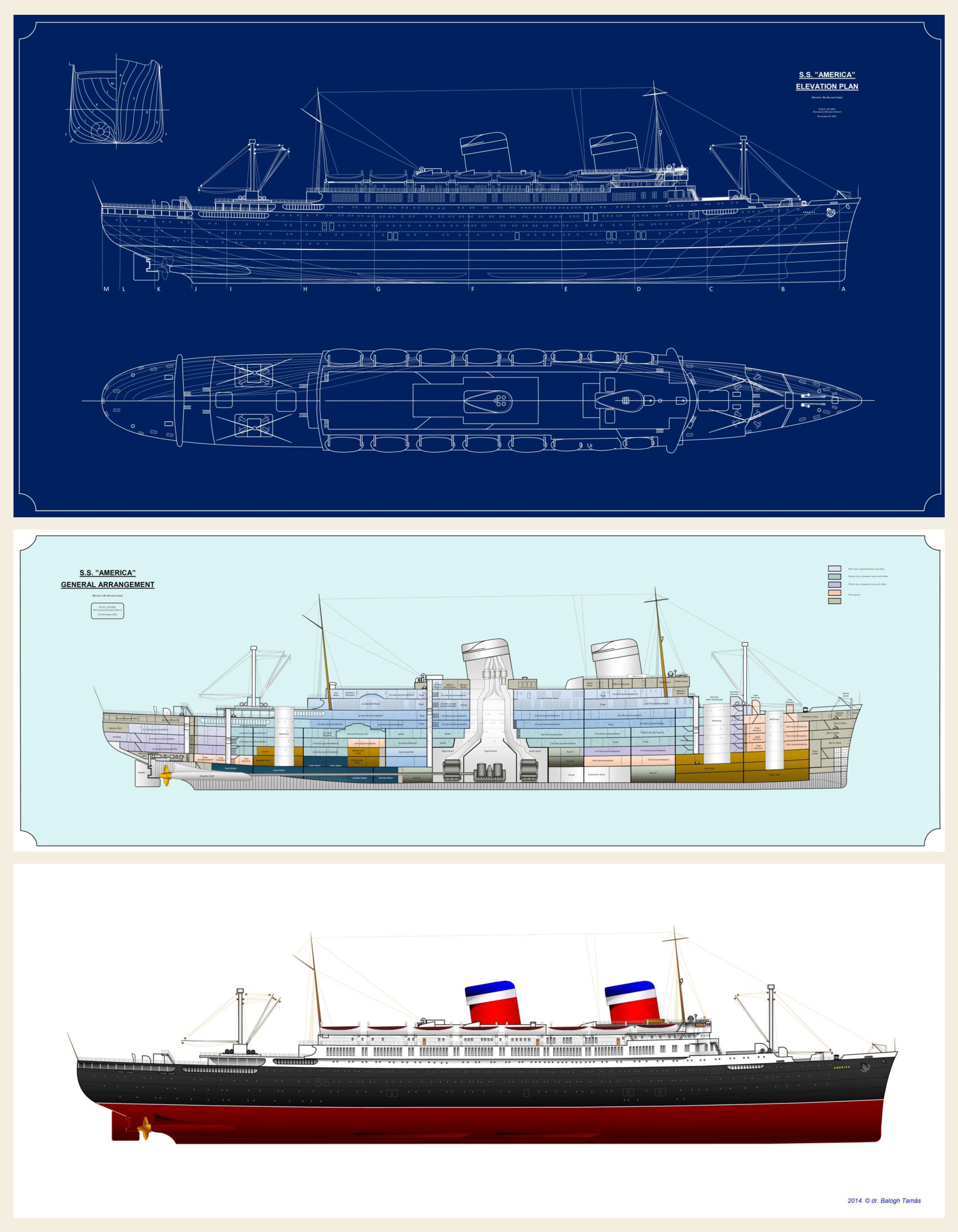
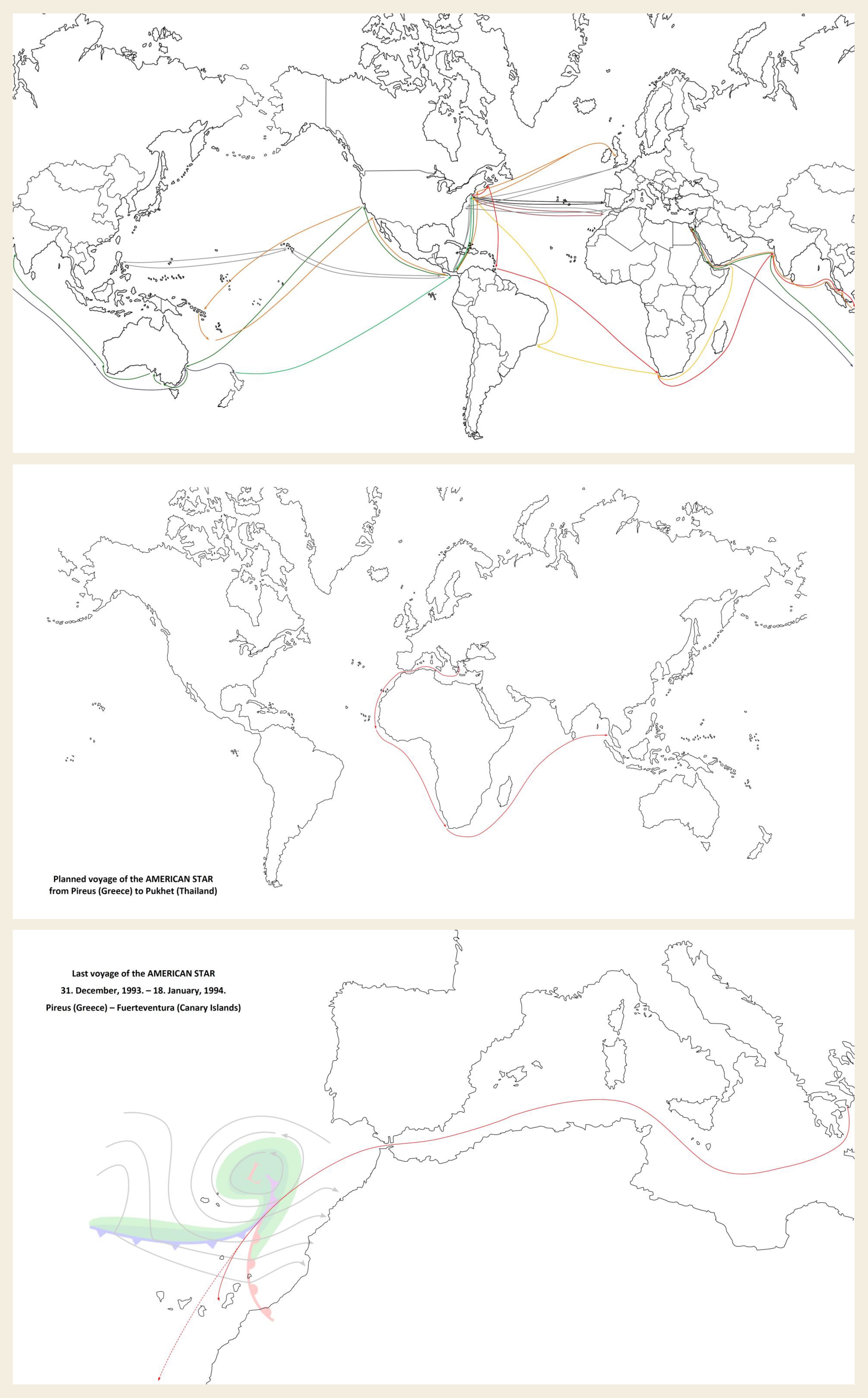
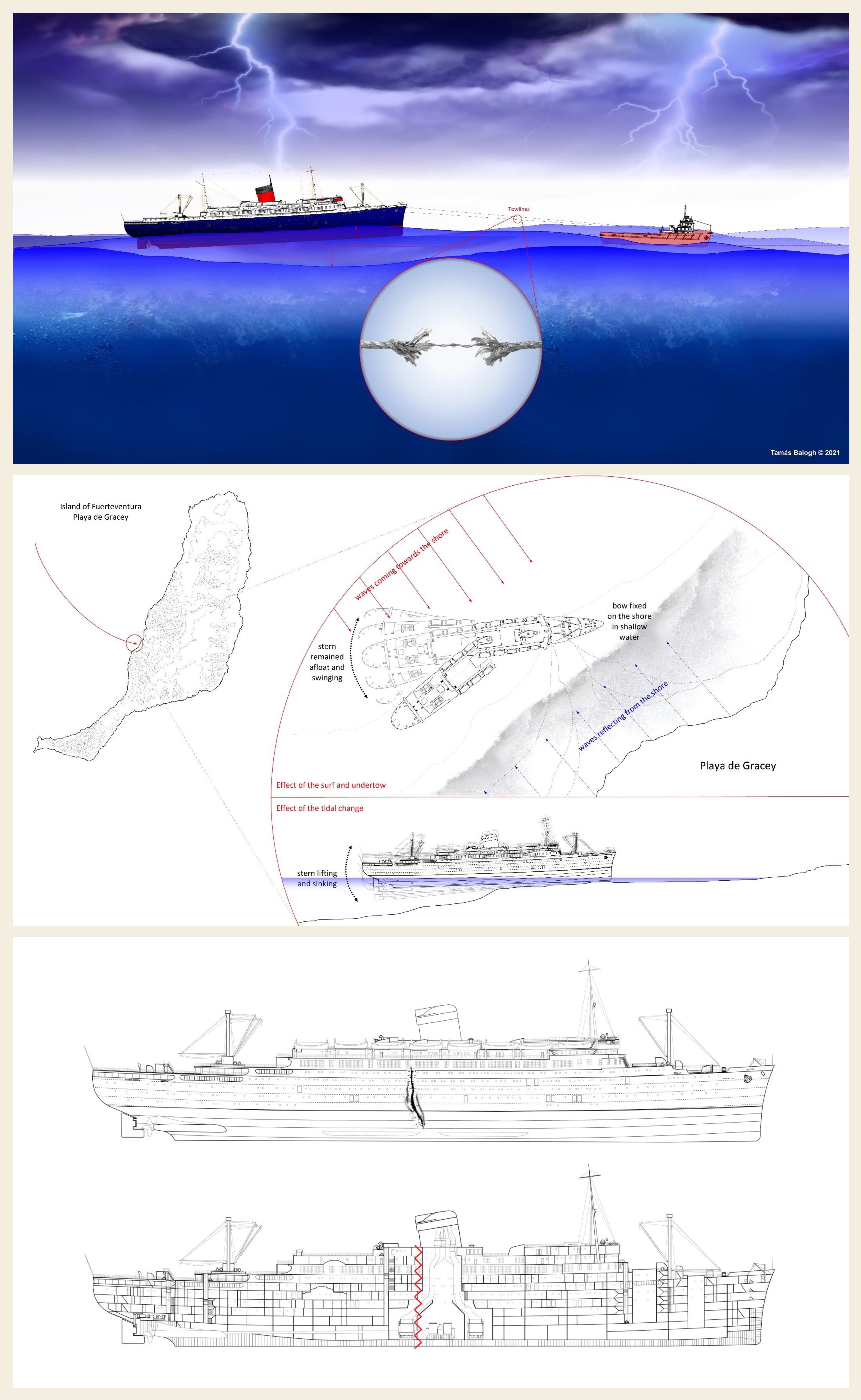
A hatodik epizódban szereplő amerikai AMERICA óceánjáró (1939-1994) történeti kutatásáról készített háttéranyag letölthető: innen.
Az AMERICA-epizód számára készített animáció előtervének vágatlan változata letölthető: innen.Nagyszerű, ha tetszik a cikk és a benne megosztott képek. Ha érdeklik a szerző munkái, az Encyclopedia of Ocean Liners Fb-oldalán találhat további információkat a szerzőről és munkásságáról.
A képek megosztása esetén, a bejegyzésben mindig tüntesse fel az alkotó nevét. Köszönöm!
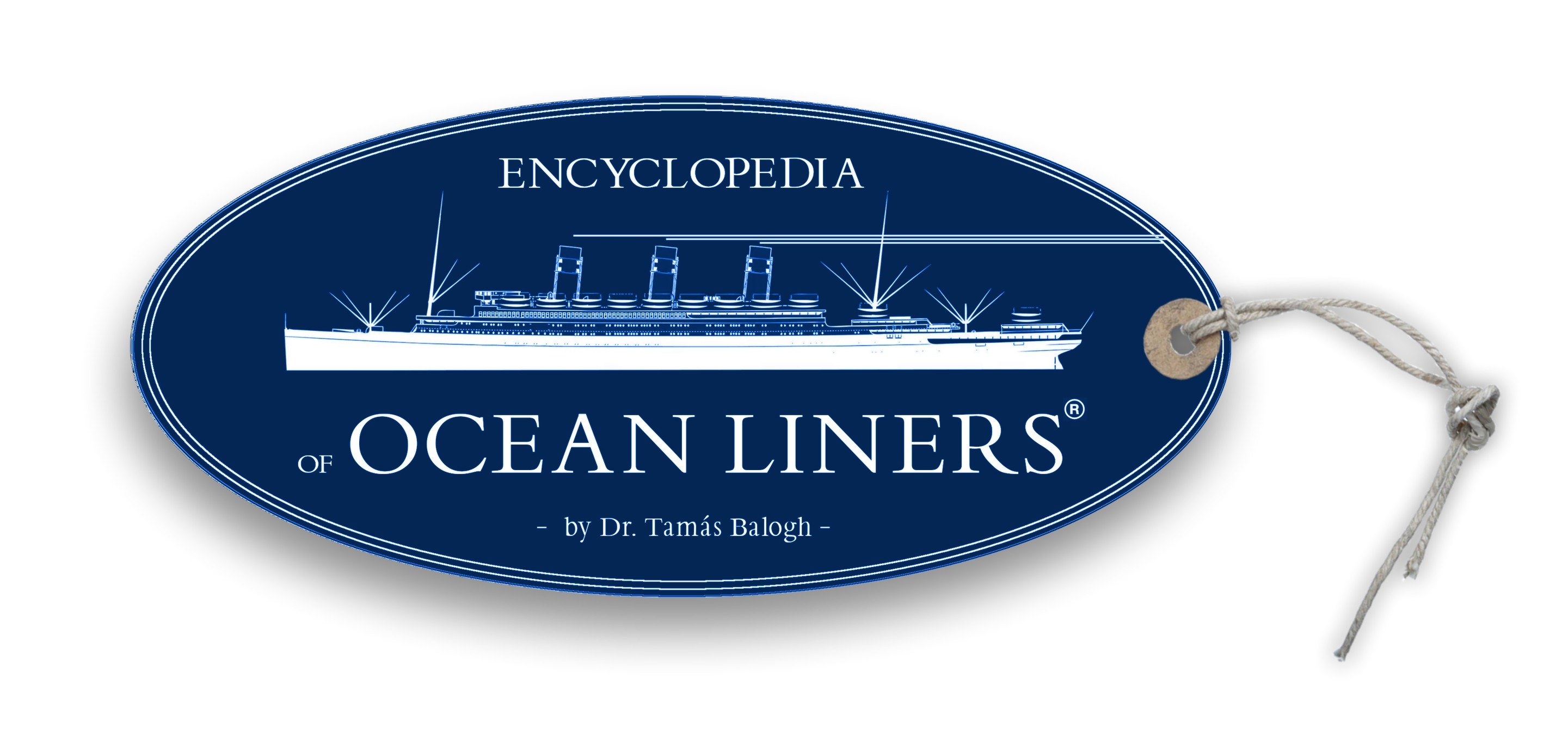
-
Secret of the Lost Liners VI. - AMERICA
The first episode of the band-new six-part documentary series "Secrets of the Lost Liners" started on Sky/History in the UK on Wednesday 27 July 2022 at 21:00. The six episodes will be shown as follows: NORMANDIE (27.07.2022.), QUEEN ELIZBETH (04.08.2022.), ANDREA DORIA (11.08.2022.), REX (18.08.2022.), CAP ARCONA (25.08.2022.), AMERICA (09.01.2022). International broadcasts are likely to follow later in 2022-2023.

This is the most extensive and detailed 6 x 1 hour on the subject. Charting a century of history of ocean liners, the most informed experts and authors tell the story how these ships were designed, built and served on the oceans, and how they eventually became victims of war, accident or human error.
On the occasion of the beginning of the presentation of the series, on the day of the screening of each episode, we will publish the background materials summarizing the research related to the history of the ocean liners in the given episode and the preliminary plans made for the animations to be shown in the series, both prepared by the president of our association, Dr. Tamás Balogh, who worked as animation director, responsible for the design and production of the technical animations presented in the series.



The background material on the historical research of the American ocean liner AMERICA (1939-1994) featured in the sixth episode can be downloaded here.
The uncut version of the animation draft for the AMERICA episode can be downloaded here.
It would be great if you like the article and pictures shared. If you are interested in the works of the author, you can find more information about the author and his work on the Encyclopedia of Ocean Liners Fb-page.
If you would like to share the pictures, please do so by always mentioning the artist's name in a credit in your posts. Thank You!

-
A LUSITANIA titkairól számolt be a National Geographic Magazin
2022. július 6-14. között járt az Atlanti-óceánban nyugvó LUSITANIA brit óriásgőzös maradványainál az első olyan expedíció, amelynek német és magyar tagjai is voltak, s amelynek első ízben sikerült bejutni a hajó legelső kazánházába és alaposan felderíteni azt. Ebből az alkalomból írt cikket az expedíció szervezésében a merülési célok kijelölésével és a búvárok által készített víz alatti felvételek kiértékelésével közreműködő Dr. Balogh Tamás -egyesületünk elnöke - amely most a National Geographic Magazin magyar kiadásának weboldalán olvasható.
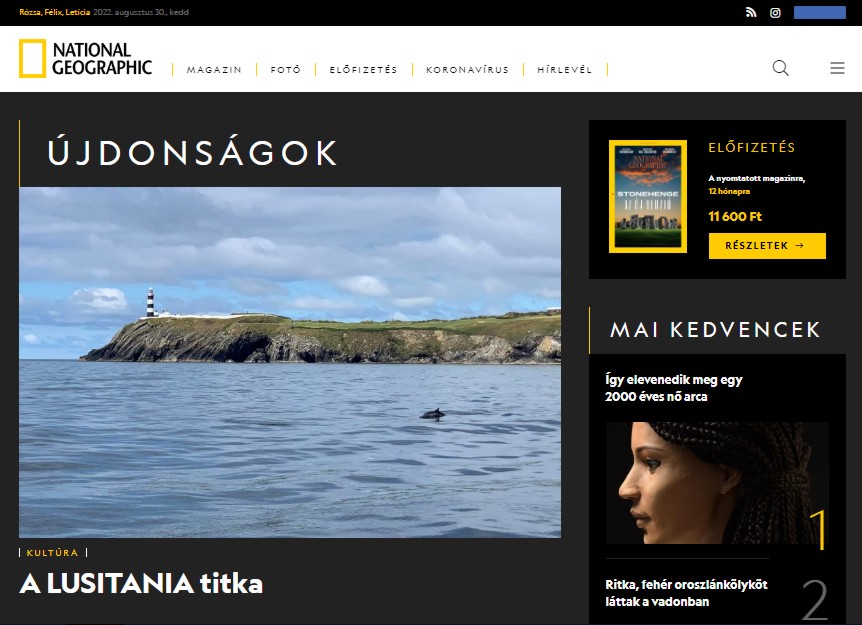
1. kép: Címlapon a LUSITANIA.
A legújabb kutatási eredményeket összefoglaló cikk elérhető innen.
Az alábbiakban megosztunk néhány, az expedíció ideje alatt a helyszínen kézzel készített rajzot, amelyek a roncs elsüllyedést közvetlenül követő 1915-ös, és a mai, 2022-es állapotát mutatják a hajó tat-részén, amely a 7 napig tartó kutatás első felének központi területe volt.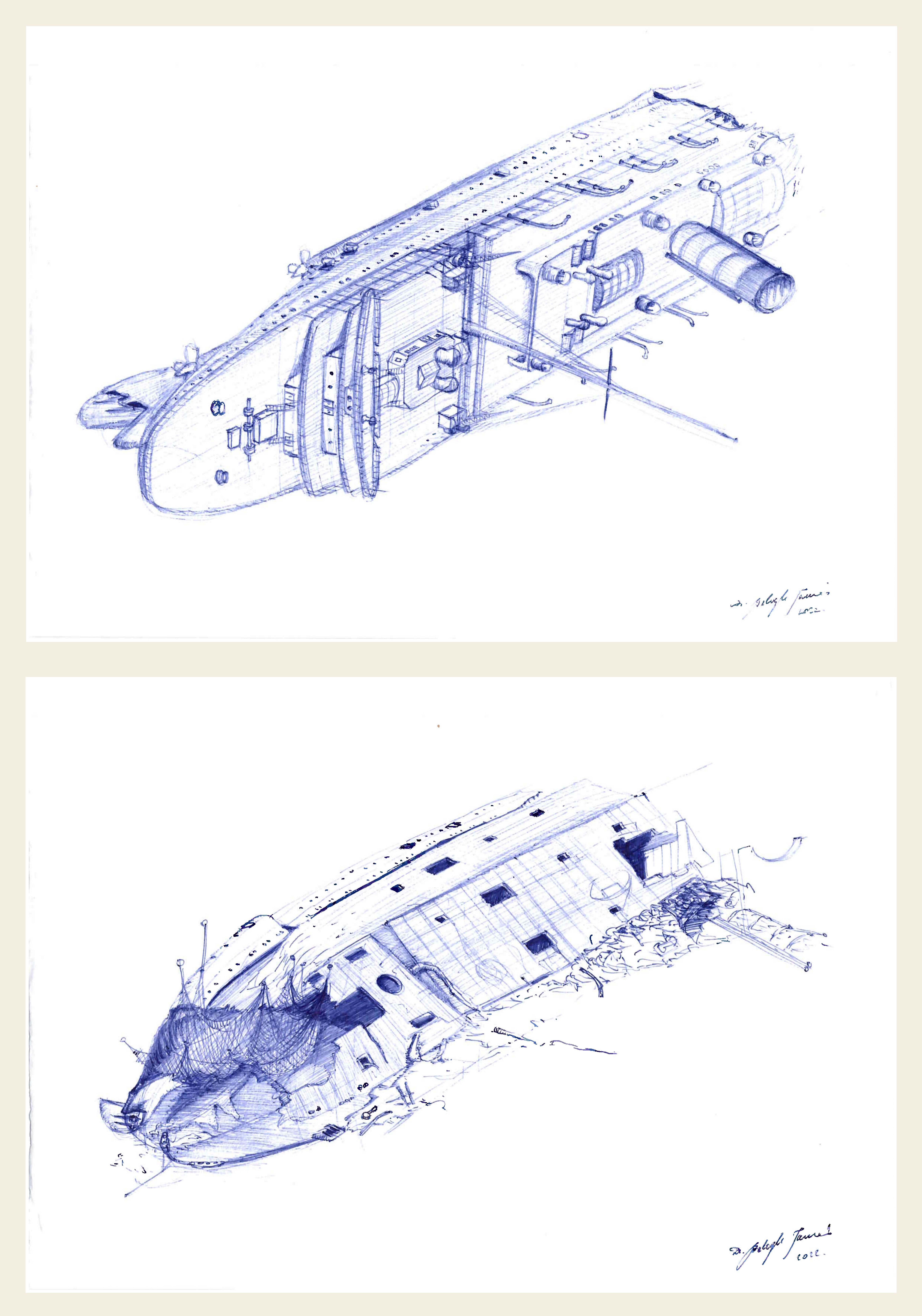
2. kép: A LUSITANIA tat-része a tengerfenéken a csónakfedélzet felől nézve 1915-ben (fent) és 2022-ben (lent). Készítette: Dr. Balogh Tamás © 2022.
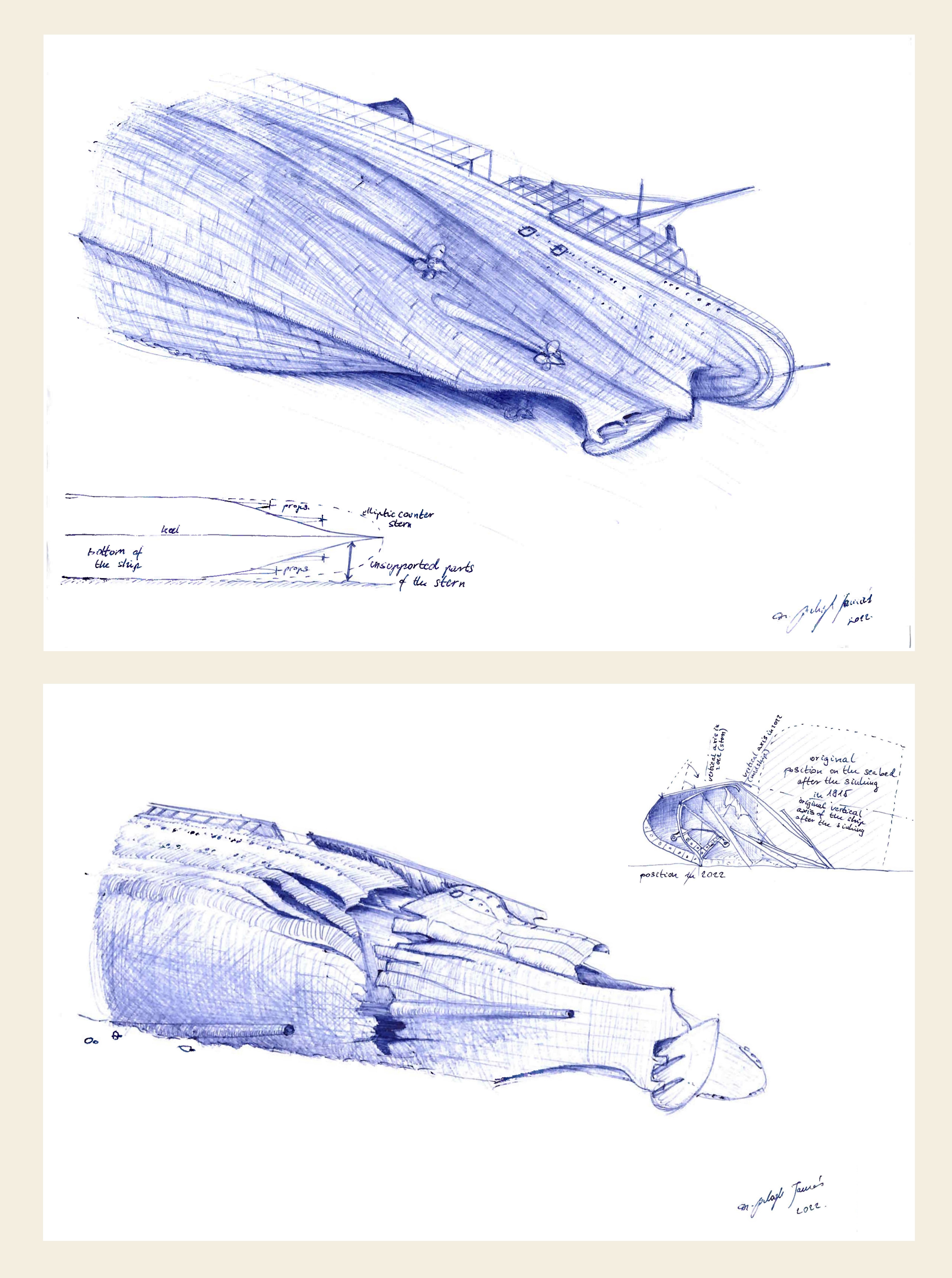
3. kép: A LUSITANIA tat-része a tengerfenéken a hajófenék felől nézve 1915-ben (fent) és 2022-ben (lent). Készítette: Dr. Balogh Tamás © 2022.

4. kép: A LUSITANIA roncsainak áttekintő ábrázolása a hajóorr felől nézve 2022-ben. Készítette: Dr. Balogh Tamás © 2022.
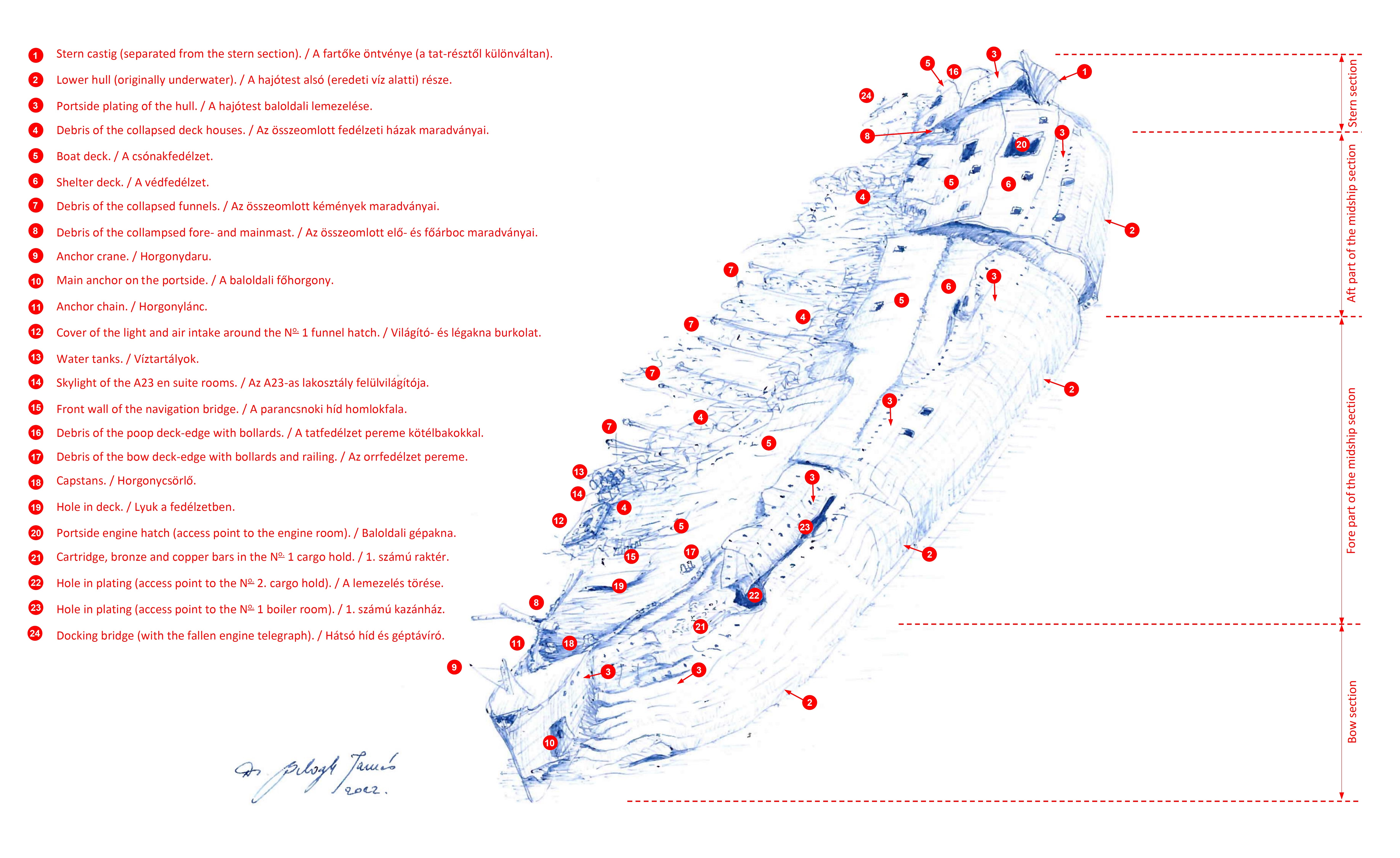
5. kép: Az expedíció által felkeresett pontok a LUSITANIA roncsain. Készítette: Dr. Balogh Tamás © 2022.
Nagyszerű, ha tetszik a cikk és a benne megosztott képek. Ha érdeklik a szerző munkái, az Encyclopedia of Ocean Liners Fb-oldalán találhat további információkat a szerzőről és munkásságáról.
A képek megosztása esetén, a bejegyzésben mindig tüntesse fel az alkotó nevét. Köszönöm!

-
A LEITHA/LAJTA monitor a Hídépítők napján
2022. augusztus 27-én, szombaton 15:00-18:30 óra között kerül megrendezésre a Hídépítők napja Balatonalmádiban. A rendezvényen - a MH 1. Honvéd Tűzszerész és Hadihajós Ezred kiállító-sátrában a LEITHA/LAJTA monitor történetét bemutató "150 év szolgálat" c., az alakulattal és a MH Budapesti Nyugállományúak Lubja Hadihajós Tagozatával közösen létrehozott országjáró vándorkiállításunk is megtekinthető.
A kiállításon egyebek között megtekinthető 60 db hajómodell és 15 db felszerelési tárgy, s - ha már Balaton és Hídépítők napja - a HELKA csavargőzös (Valentinyi Gyula alkotása), valamint a CLARK ÁDÁM és a brazil megrendelésre épült 200 tonnás úszódaruk modelljei (Nagy András alkotásai).
További információk a Hídépítők napjártól: itt.
További információk a kiállításról: itt, itt és itt.
Minden érdeklődőt szeretettel várunk.
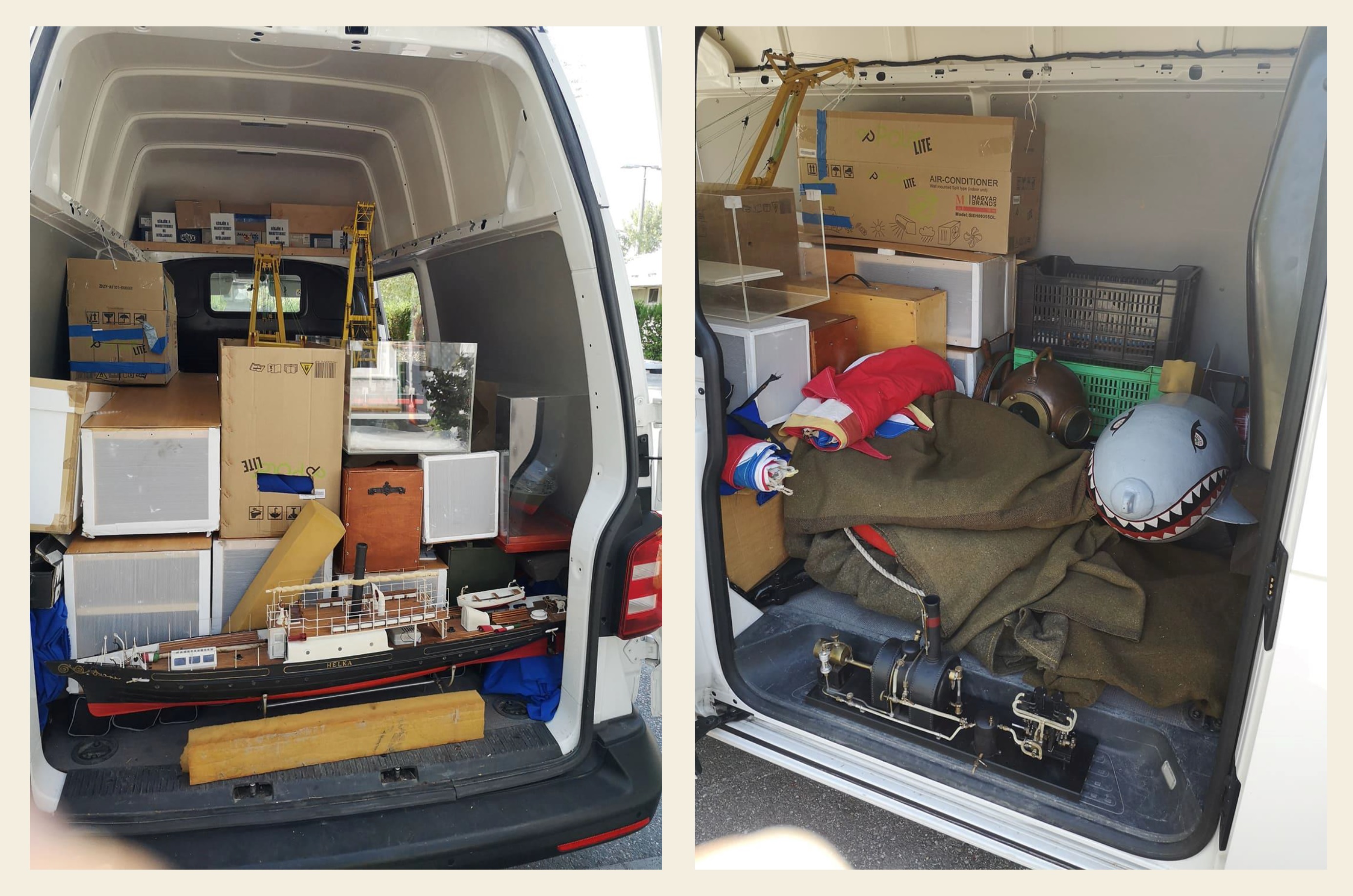
1. kép: Utazik a kiállítás (fotó: Hocza István).
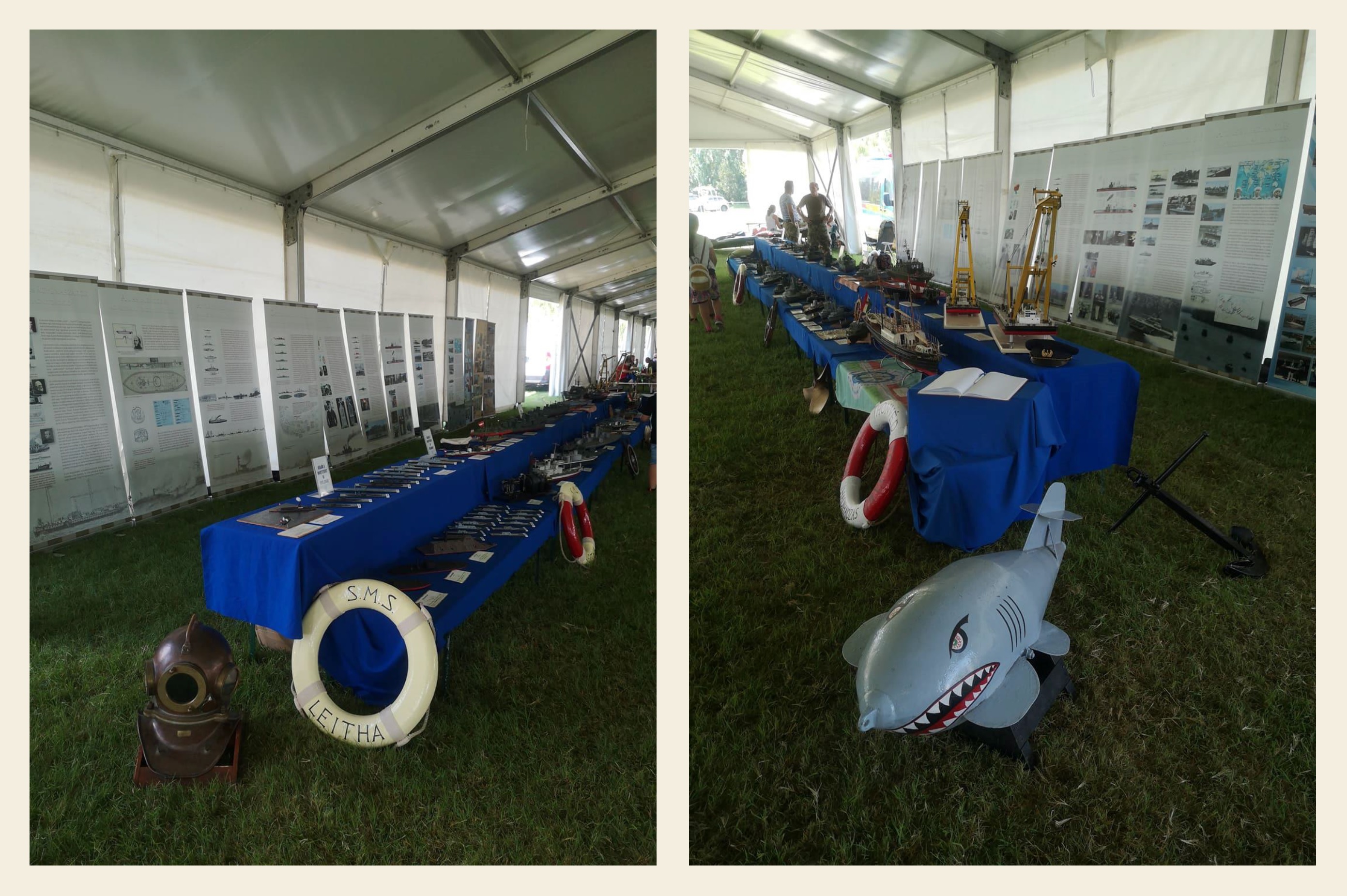
2. kép: A látogatókat váró, berendezett tárlat a megnyitó előtt (fotó: Hocza István).
-
Elveszett óceánjárók titkai V. - CAP ARCONA
Az "Elveszett óceánjárók titkai" című vadonatúj hatrészes dokumentum-film sorozat első epizódját 2022. július 27-én, szerdán 21:00 órakor kezdték el vetíteni a Sky/History televíziós csatornán az Egyesült Királyságban. A hat epizód vetítésére az alábbiak szerint kerül sor: NORMANDIE (2022.07.27.), QUEEN ELIZBETH (2022.08.04.), ANDREA DORIA (2022.08.11.), REX (2022.08.18.), CAP ARCONA (2022.08.25.), AMERICA (2022.09.01.). A nemzetközi adások valószínűleg később, 2022-2023 folyamán következnek.

Ez a legkiterjedtebb és legrészletesebb 6 x 1 óra a témában. Az óceánjárók egy évszázadnyi történetét feltérképezve a legtájékozottabb szakértők és szerzők mesélnek arról, hogyan tervezték, építették ezeket a hajókat és hogyan szolgáltak az óceánon, s végül hogyan váltak a háború, balesetek, vagy emberi mulasztások áldozatává.
A sorozat bemutatásának megkezdése alkalmából az egyes epizódok vetítésének napján közreadjuk az adott epizódban szereplő óceánjárók történetéhez kapcsolódó kutatásokat összefoglaló háttéranyagokat és a sorozatban megjelenítendő animációkhoz készített előzetes terveket, amelyeket egyesületünk elnöke, Dr. Balogh Tamás készített, aki a sorozatban bemutatott műszaki animációk elkészítéséért felelős rendezőként dolgozott.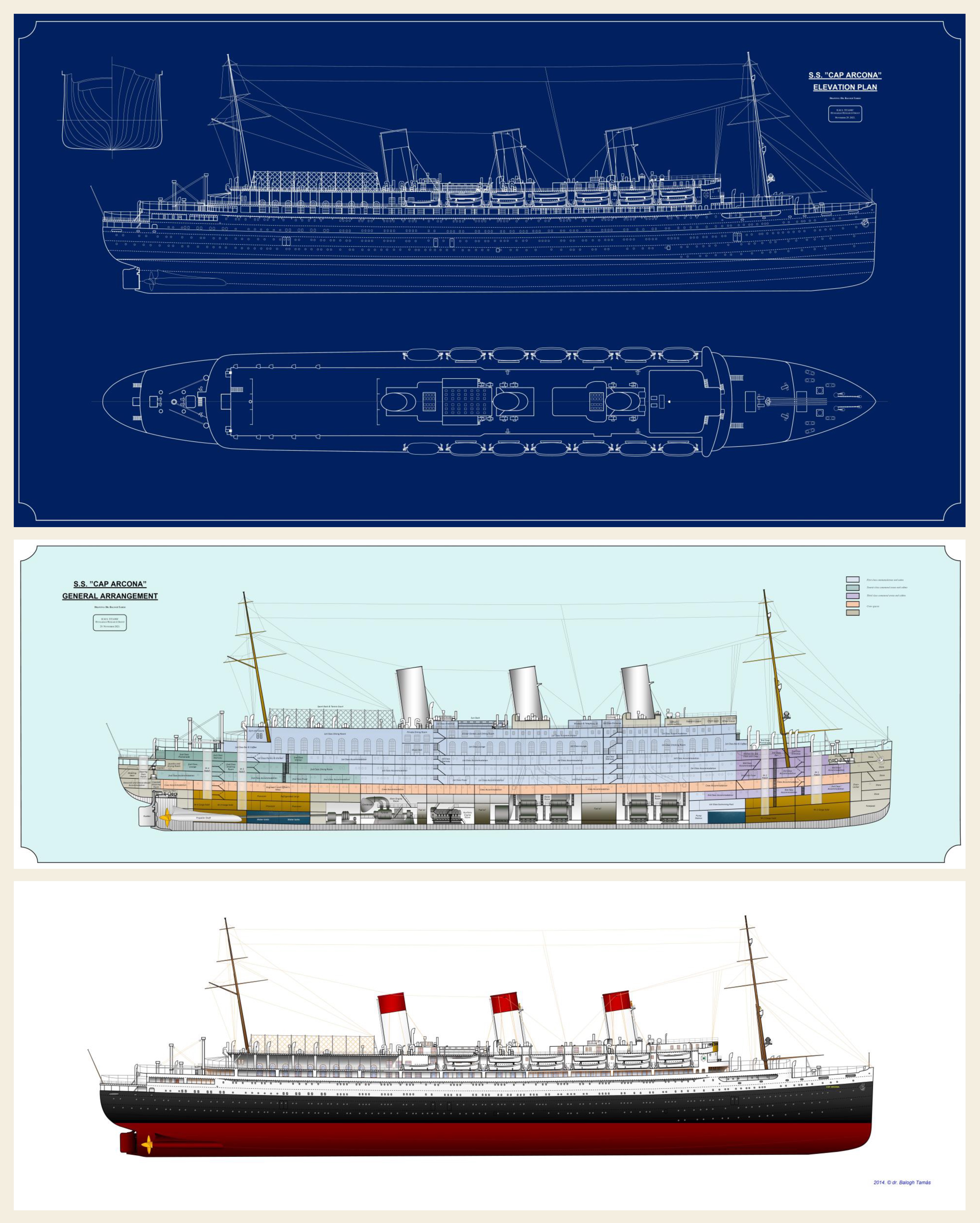
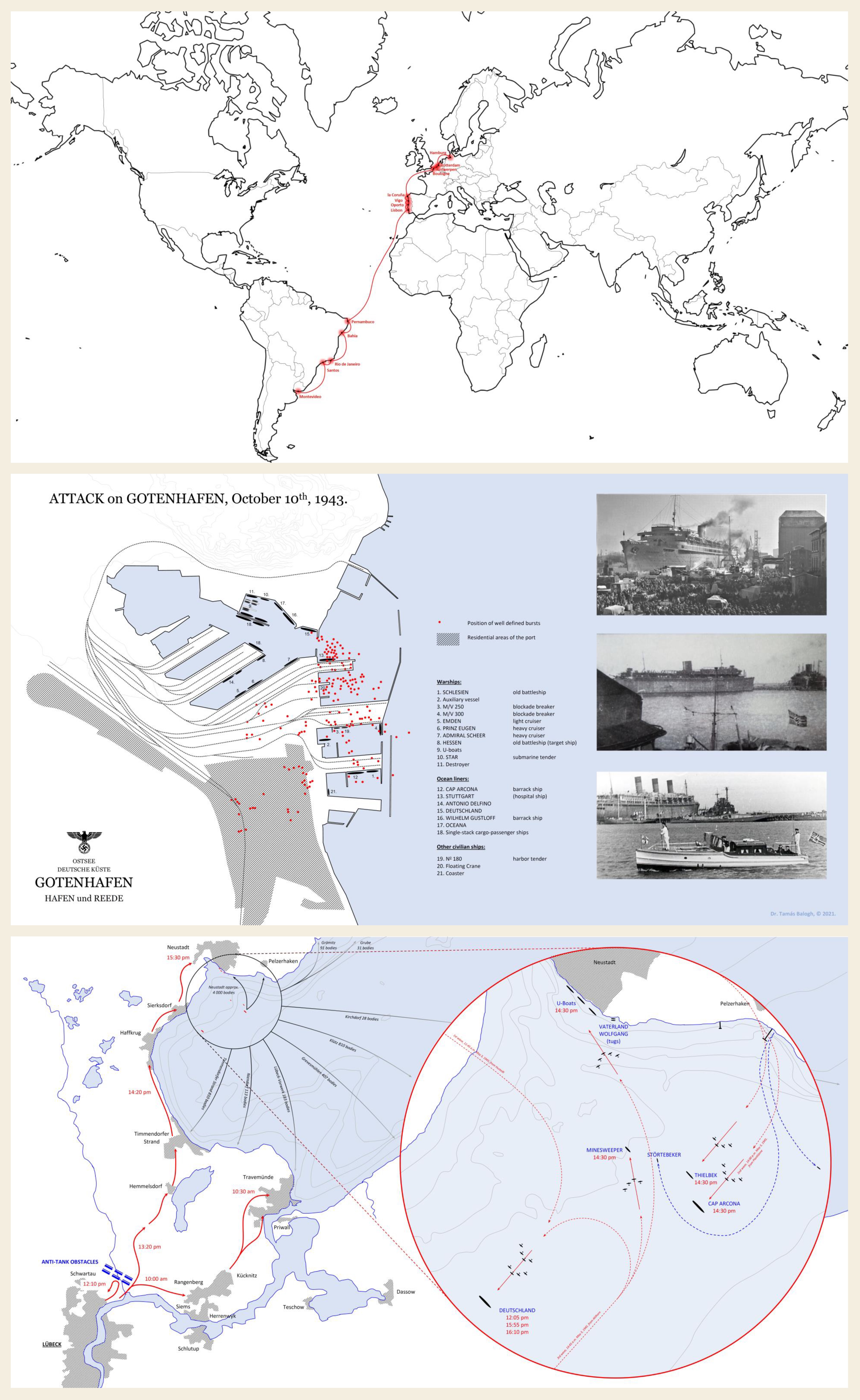
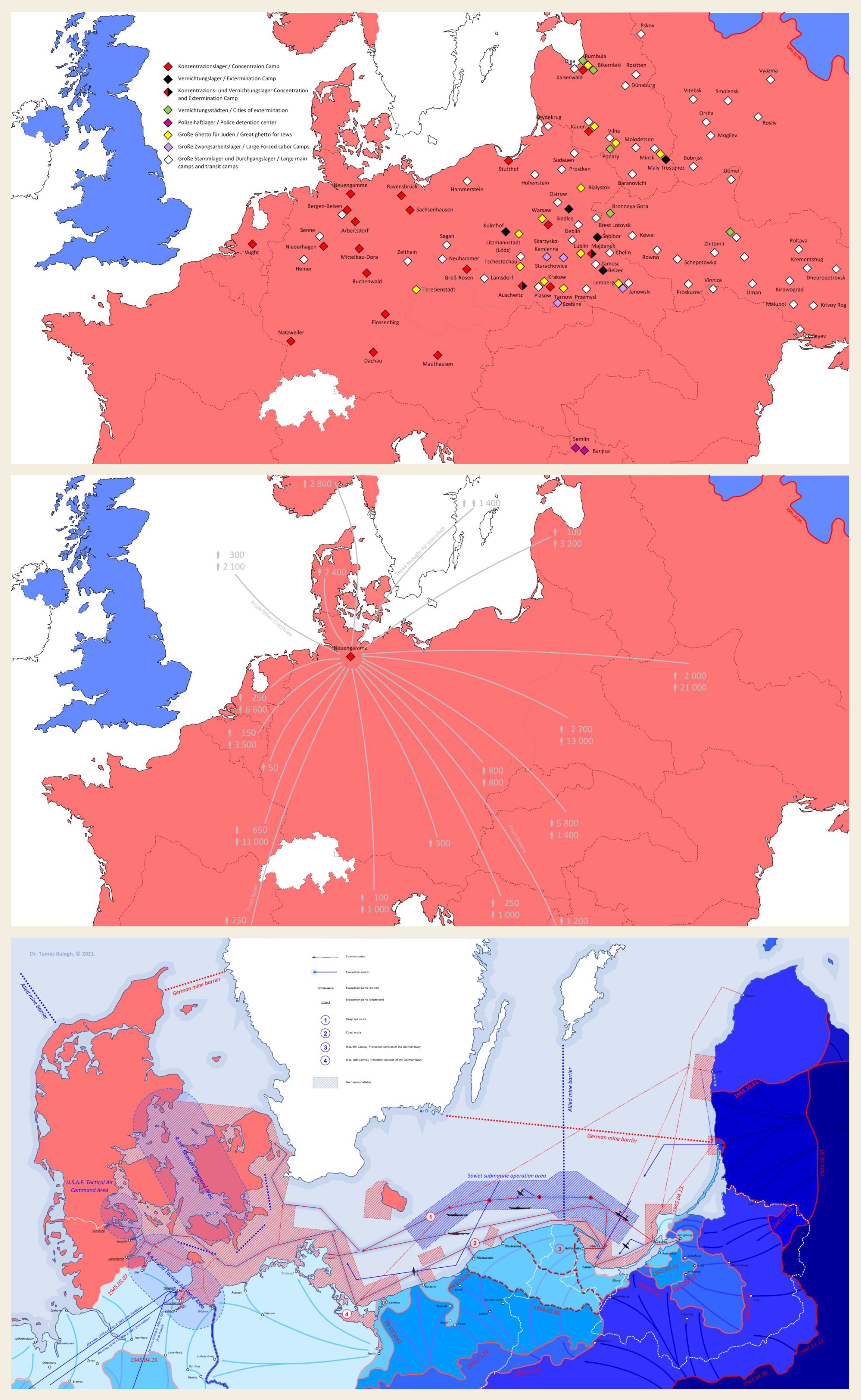
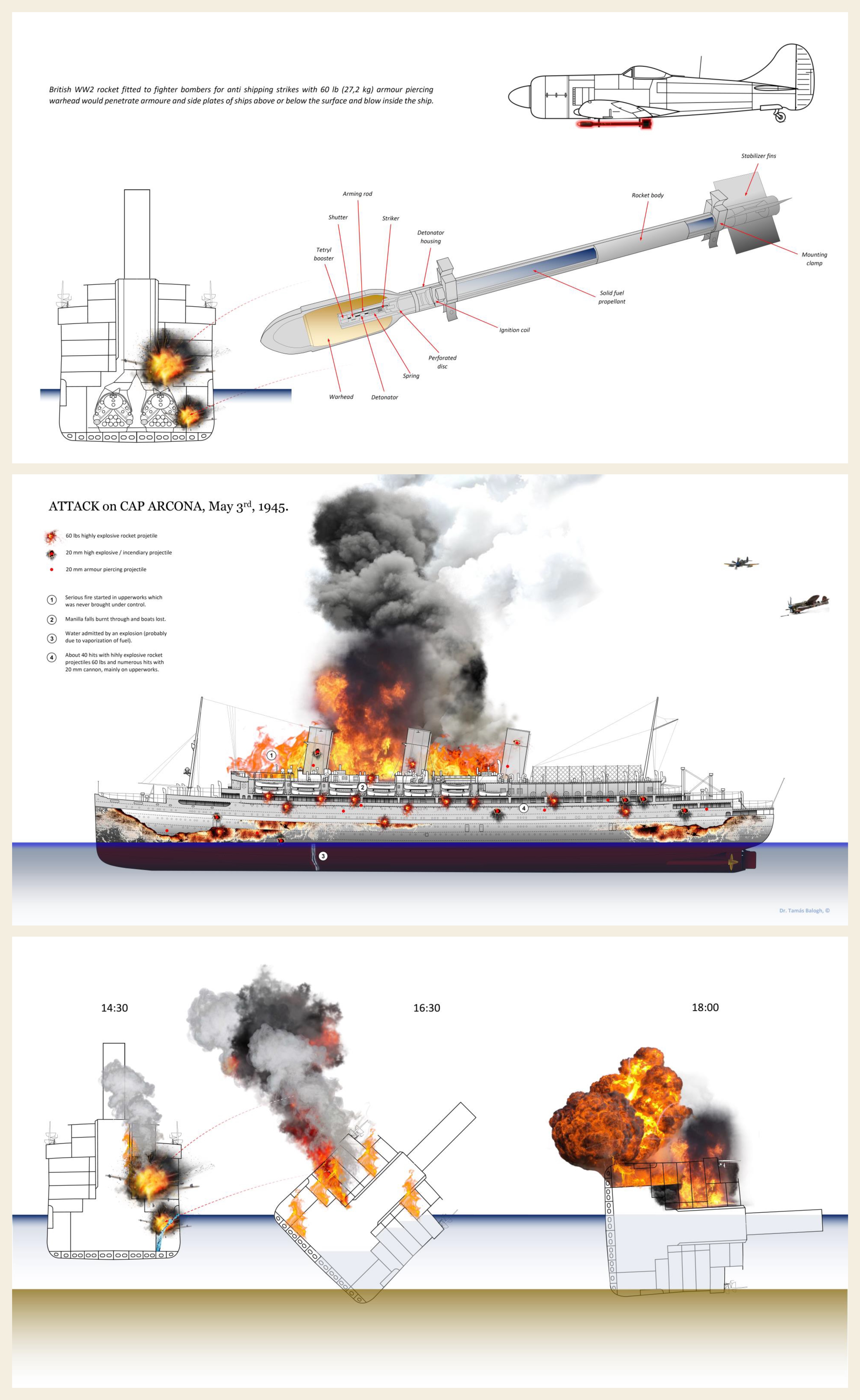
Az ötödik epizódban szereplő német CAP ARCONA óceánjáró (1927-1945) történeti kutatásáról készített háttéranyag letölthető: innen.
A CAP ARCONA-epizód számára készített animáció előtervének vágatlan változata letölthető: innen.Nagyszerű, ha tetszik a cikk és a benne megosztott képek. Ha érdeklik a szerző munkái, az Encyclopedia of Ocean Liners Fb-oldalán találhat további információkat a szerzőről és munkásságáról.
A képek megosztása esetén, a bejegyzésben mindig tüntesse fel az alkotó nevét. Köszönöm!

-
Secret of the Lost Liners V. - CAP ARCONA
The first episode of the band-new six-part documentary series "Secrets of the Lost Liners" started on Sky/History in the UK on Wednesday 27 July 2022 at 21:00. The six episodes will be shown as follows: NORMANDIE (27.07.2022.), QUEEN ELIZBETH (04.08.2022.), ANDREA DORIA (11.08.2022.), REX (18.08.2022.), CAP ARCONA (25.08.2022.), AMERICA (09.01.2022). International broadcasts are likely to follow later in 2022-2023.

This is the most extensive and detailed 6 x 1 hour on the subject. Charting a century of history of ocean liners, the most informed experts and authors tell the story how these ships were designed, built and served on the oceans, and how they eventually became victims of war, accident or human error.
On the occasion of the beginning of the presentation of the series, on the day of the screening of each episode, we will publish the background materials summarizing the research related to the history of the ocean liners in the given episode and the preliminary plans made for the animations to be shown in the series, both prepared by the president of our association, Dr. Tamás Balogh, who worked as animation director, responsible for the design and production of the technical animations presented in the series.




The background material on the historical research of the German ocean liner CAP ARCONA (1927-1945) featured in the fifth episode can be downloaded here.
The uncut version of the animation draft for the CAP ARCONA episode can be downloaded here.
It would be great if you like the article and pictures shared. If you are interested in the works of the author, you can find more information about the author and his work on the Encyclopedia of Ocean Liners Fb-page.
If you would like to share the pictures, please do so by always mentioning the artist's name in a credit in your posts. Thank You!

-
Elveszett óceánjárók titkai IV. - REX
Az "Elveszett óceánjárók titkai" című vadonatúj hatrészes dokumentum-film sorozat első epizódját 2022. július 27-én, szerdán 21:00 órakor kezdték el vetíteni a Sky/History televíziós csatornán az Egyesült Királyságban. A hat epizód vetítésére az alábbiak szerint kerül sor: NORMANDIE (2022.07.27.), QUEEN ELIZBETH (2022.08.04.), ANDREA DORIA (2022.08.11.), REX (2022.08.18.), CAP ARCONA (2022.08.25.), AMERICA (2022.09.01.). A nemzetközi adások valószínűleg később, 2022-2023 folyamán következnek.

Ez a legkiterjedtebb és legrészletesebb 6 x 1 óra a témában. Az óceánjárók egy évszázadnyi történetét feltérképezve a legtájékozottabb szakértők és szerzők mesélnek arról, hogyan tervezték, építették ezeket a hajókat és hogyan szolgáltak az óceánon, s végül hogyan váltak a háború, balesetek, vagy emberi mulasztások áldozatává.
A sorozat bemutatásának megkezdése alkalmából az egyes epizódok vetítésének napján közreadjuk az adott epizódban szereplő óceánjárók történetéhez kapcsolódó kutatásokat összefoglaló háttéranyagokat és a sorozatban megjelenítendő animációkhoz készített előzetes terveket, amelyeket egyesületünk elnöke, Dr. Balogh Tamás készített, aki a sorozatban bemutatott műszaki animációk elkészítéséért felelős rendezőként dolgozott.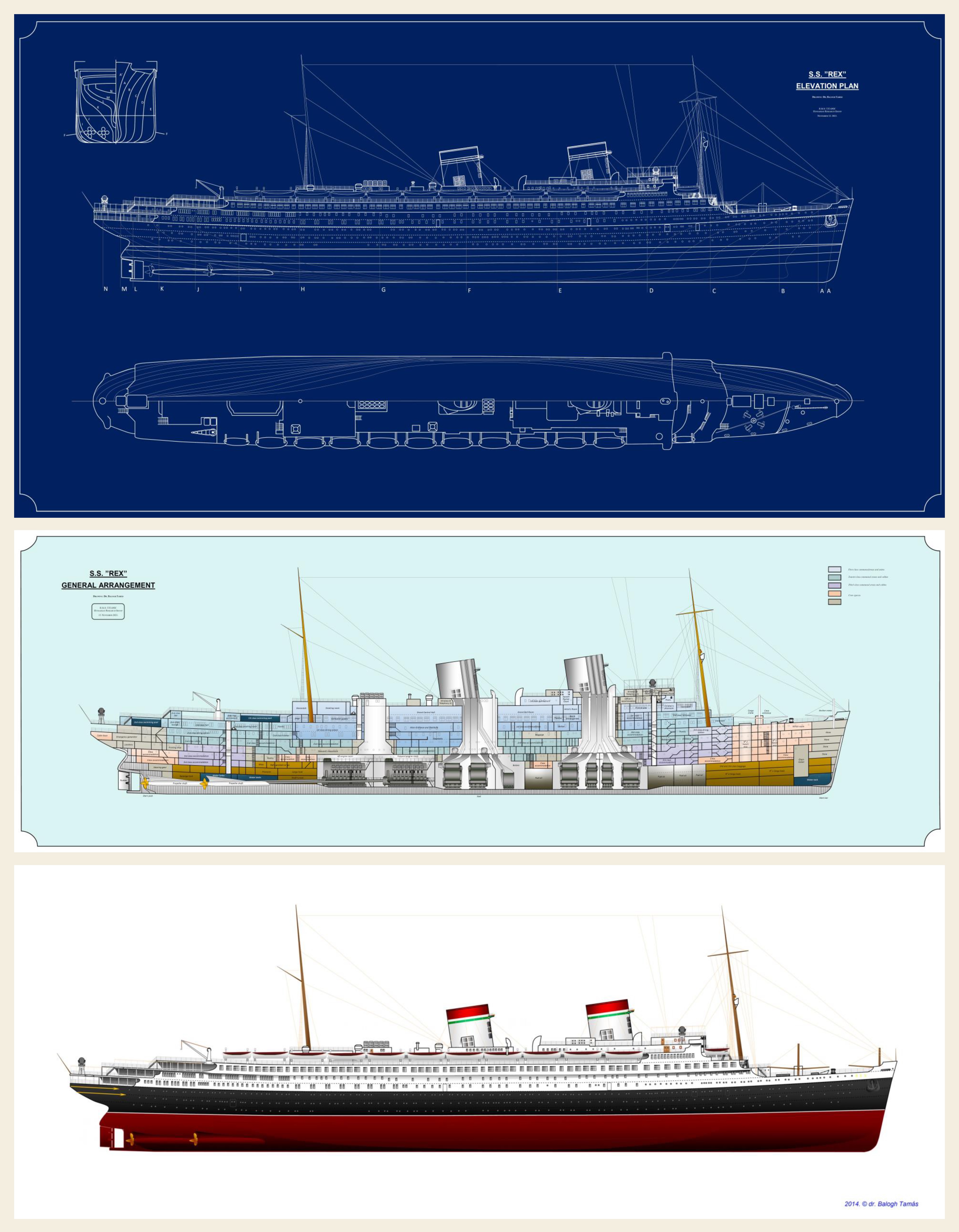
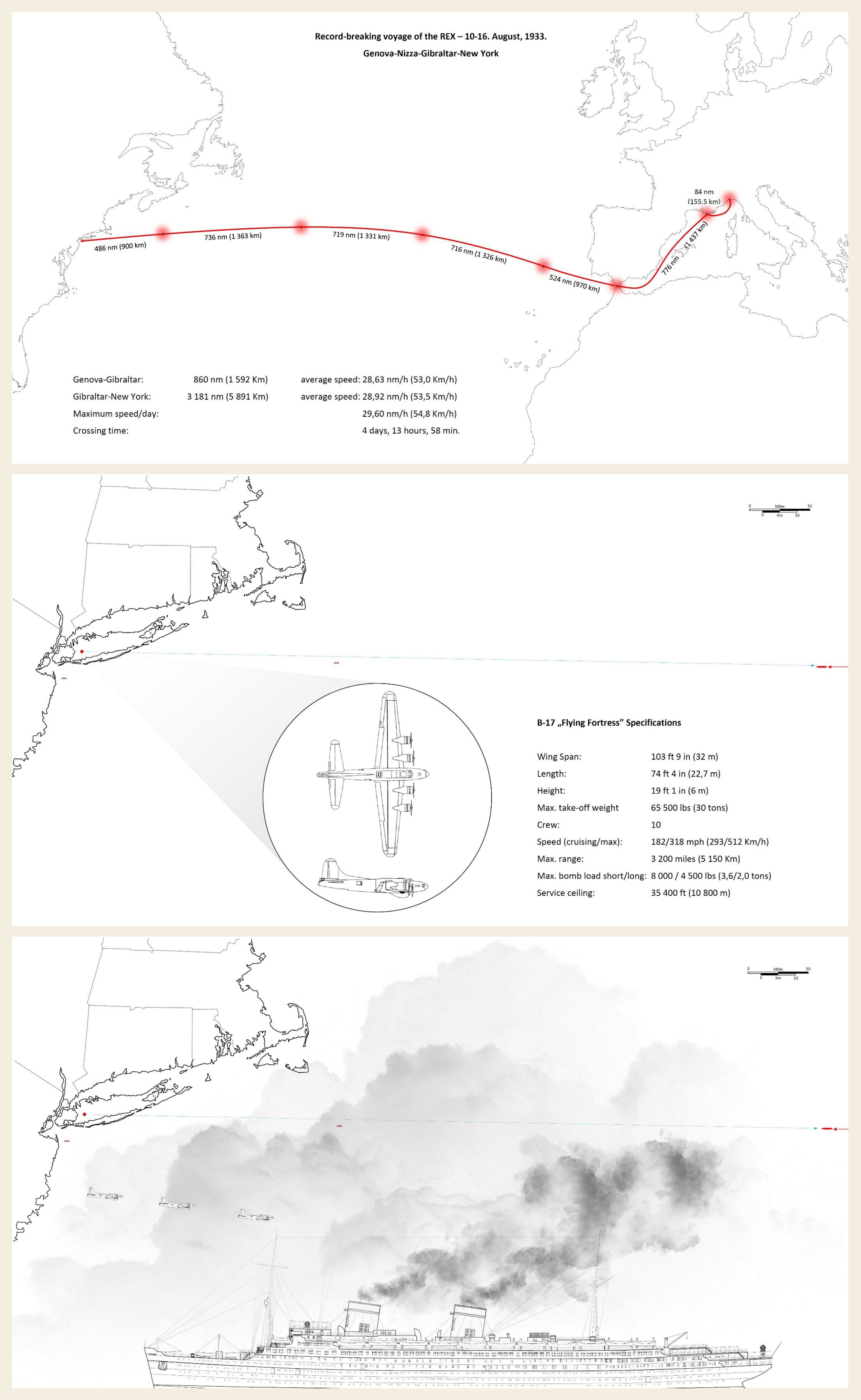
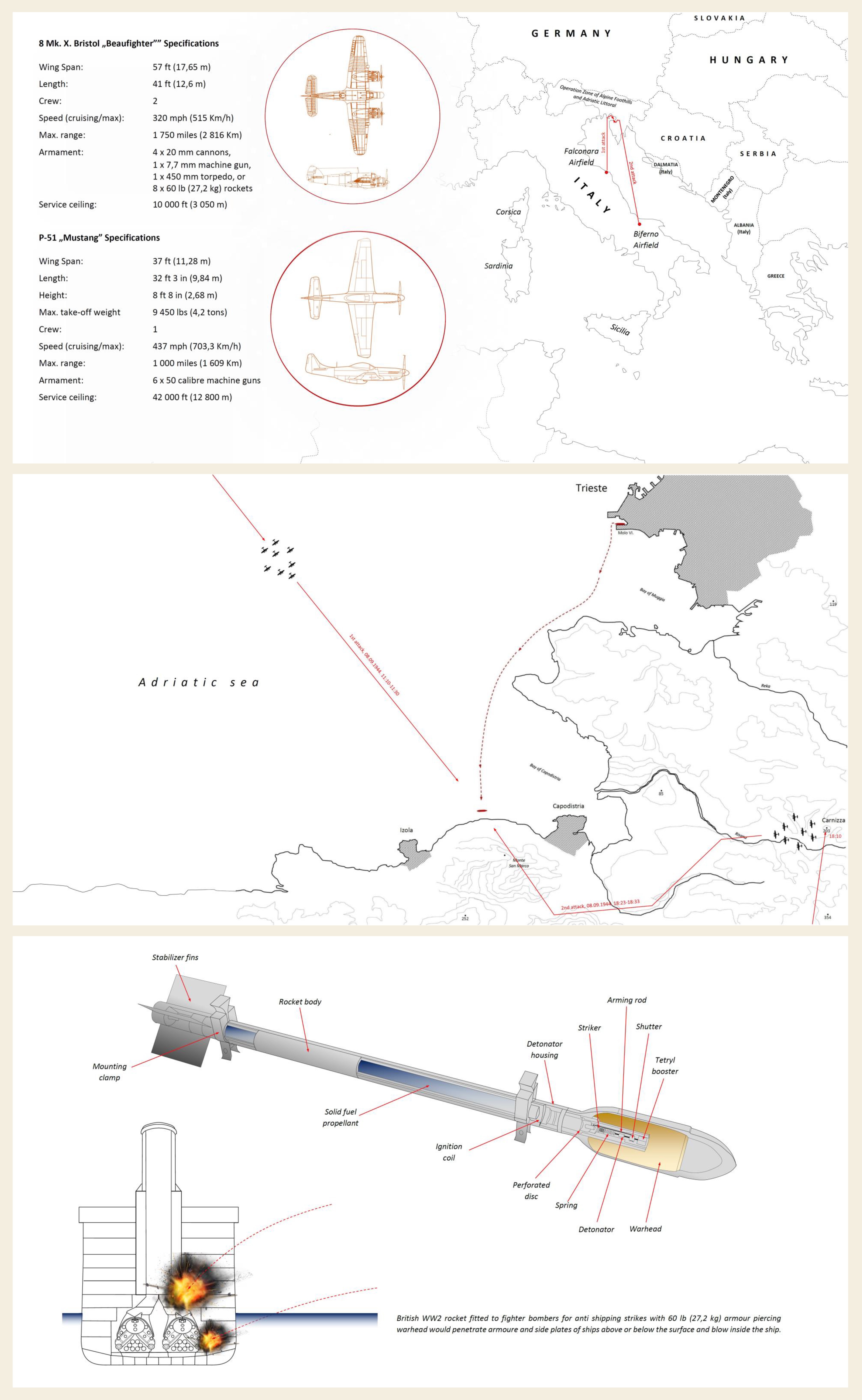
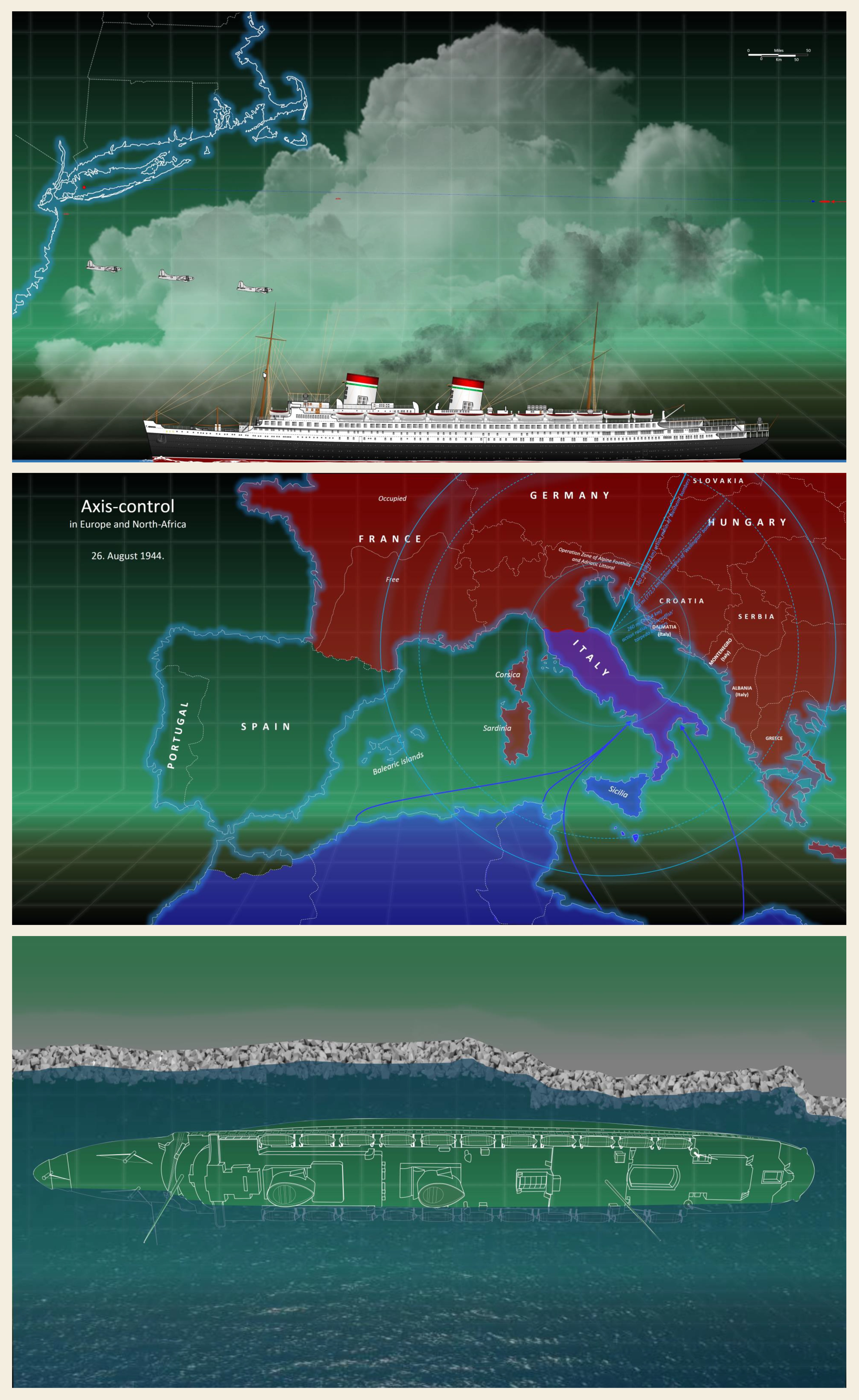
A negyedik epizódban szereplő olasz REX óceánjáró (1931-1944) történeti kutatásáról készített háttéranyag letölthető: innen.
A REX-epizód számára készített animáció előtervének vágatlan változata letölthető: innen.Nagyszerű, ha tetszik a cikk és a benne megosztott képek. Ha érdeklik a szerző munkái, az Encyclopedia of Ocean Liners Fb-oldalán találhat további információkat a szerzőről és munkásságáról.
A képek megosztása esetén, a bejegyzésben mindig tüntesse fel az alkotó nevét. Köszönöm!

